A Simple and Efficient Approach to the Synthesis of 4-Aryl-2-dialkylphosphonomethyl-4-oxobutanenitrile
Abstract
:1. Introduction
2. Results and Discussion
Chemistry
3. Molecular Docking Study
4. Material and Methods
4.1. Chemistry
4.2. General Procedure for the Preparation of 2-Dialkylphosphonomethylpropenenitrile 3
4.2.1. Step 1: Preparation of the Ammonium Salt
4.2.2. Step 2: Synthesis of Allylphosphonates 3
4.3. General Procedure for the Preparation of 4-Aryl-2-dialkylphosphonomethyl-4-oxobutanenitrile 5
5. Molecular Docking Study
5.1. Protein and Ligand Preparation
Molecular Docking
6. Conclusions
Supplementary Materials
Author Contributions
Funding
Institutional Review Board Statement
Informed Consent Statement
Data Availability Statement
Conflicts of Interest
Sample Availability
References
- Iida, H.; Moromizato, T.; Hamana, H.; Matsumoto, K. An efficient conjugate hydrocyanation of chalcones and related enones with TMSCN under solvent-and additive-free microwave conditions. Tetrahedron Lett. 2007, 48, 2037–2039. [Google Scholar] [CrossRef]
- Stetter, H.; Schreckenberg, M. Addition of aldehydes to activated double bonds. Angew. Chem. 1973, 85, 89. [Google Scholar] [CrossRef]
- Stetter, H. Addition aliphatischer Aldehyde an aktivierte Doppelbindungen. Angew. Chem. 1974, 86, 589. [Google Scholar] [CrossRef]
- Kaminski, T. Synthèse de dérivés de la 4-(méthylnitroasamino)-1-(3-pyridyl)-1-butanone (NNK). Ph.D. Thesis, Université Paul Verlaine-Metz, Metz, France, 2007. [Google Scholar]
- Stetter, H.; Kuhlmann, H. Addition von aliphatischen, heterocyclischen und aromatischen Aldehyden an α, β-ungesättigte Ketone, Nitrile und Ester. Chem. Ber. 1976, 109, 2890–2896. [Google Scholar] [CrossRef]
- Mrabet, H.; Zantour, H. Nouvelles voies d’acces aux 2-ethoxycarbonylallylphosphonates. Phosphorus Sulfur Silicon 2004, 179, 25–33. [Google Scholar] [CrossRef]
- Yaccoubi, F.; Efrit, M.; Zantour, H. Synthèse d’aminopyrazolines phosphonométhylées. J. Soc. Chim. Tunis. 2005, 7, 89–96. [Google Scholar]
- Abdelli, A.; Efrit, M.L.; Gaucher, A.; M’rabet, H.; Prim, D. A convenient synthesis of phosphonomethyl α, β-unsaturated γ-lactams. Tetrahedron Lett. 2015, 56, 5397–5400. [Google Scholar] [CrossRef]
- Abdelli, A.; M’rabet, H.; Efrit, M.L.; Gaucher, A.; Prim, D. γ-Alkylsulfide phosphonates through the thia-Michael strategy. J. Sulfur Chem. 2014, 35, 674–682. [Google Scholar] [CrossRef]
- Grushin, V.V. Generation of “Naked” Fluoride Ions in Unprecedentedly High Concentrations from a Fluoropalladium Complex. Angew. Chem. Int. Ed. 1998, 37, 994–996. [Google Scholar] [CrossRef]
- Dong, E.; Du, H.; Gardner, L. An interactive web-based dashboard to track COVID-19 in real time. Lancet Infect. Dis. 2020, 20, 533–534. [Google Scholar] [CrossRef]
- Macchiagodena, M.; Pagliai, M.; Procacci, P. Identification of potential binders of the main protease 3CLpro of the COVID-19 via structure-based ligand design and molecular modeling. Chem. Phys. Lett. 2020, 750, 137489. [Google Scholar] [CrossRef]
- Sayers, E.W.; Beck, J.; Bolton, E.E.; Bourexis, D.; Brister, J.R.; Canese, K.; Comeau, D.C.; Funk, K.; Kim, S.; Klimke, W. Database resources of the national center for biotechnology information. Nucleic Acids Res. 2021, 49, D10. [Google Scholar] [CrossRef] [PubMed]
- Shanker, A.; Bhanu, D.; Alluri, A. Analysis of Whole Genome Sequences and Homology Modelling of a 3-C Like Peptidase and a Non-Structural Protein of the Novel Coronavirus COVID-19 Shows Protein Ligand Interaction with an Aza-Peptide and a Noncovalent Lead Inhibitor with Possible Antiviral Properties. ChemRxiv 2020. [Google Scholar] [CrossRef]
- Thiel, V.; Ivanov, K.A.; Putics, A.; Hertzig, T.; Schelle, B.; Bayer, S.; Weißbrich, B.; Snijder, E.J.; Rabenau, H.; Doerr, H.W. Mechanisms and enzymes involved in SARS coronavirus genome expression. J. Gen. Virol. 2003, 84, 2305–2315. [Google Scholar] [CrossRef] [PubMed]
- Hilgenfeld, R. From SARS to MERS: Crystallographic studies on coronaviral proteases enable antiviral drug design. FEBS J. 2014, 281, 4085–4096. [Google Scholar] [CrossRef] [PubMed] [Green Version]
- Fouad, S.A.; El-Gendey, M.S.; Ahmed, E.M.; Hessein, S.A.; Ammar, Y.A.; Zaki, Y.H. Convenient Synthesis of Some New Thiophene, Pyrazole, and Thiazole Derivatives Bearing Biologically Active Sulfonyl Guanidine Moiety. Polycycl. Aromat. Compd. 2021, 1–19. [Google Scholar] [CrossRef]
- Nassan, M.A.; Aldhahrani, A.; Amer, H.H.; Elhenawy, A.; Swelum, A.A.; Ali, O.M.; Zaki, Y.H. Investigation of the Anticancer Effect of α-Aminophosphonates and Arylidine Derivatives of 3-Acetyl-1-aminoquinolin-2(1H)-one on the DMBA Model of Breast Cancer in Albino Rats with In Silico Prediction of Their Thymidylate Synthase Inhibitory Effect. Molecules 2022, 27, 756. [Google Scholar] [CrossRef]
- Hosny, M.A.; Zaki, Y.H.; Mokbel, W.A.; Abdelhamid, A.O. Synthesis, characterization, antimicrobial activity and anticancer of some new pyrazolo [1, 5-a] pyrimidines and pyrazolo [5, 1-c] 1, 2, 4-triazines. Med. Chem. 2020, 16, 750–760. [Google Scholar] [CrossRef]
- Gomha, S.M.; Zaki, Y.H.; Abdelhamid, A.O. Utility of 3-Acetyl-6-bromo-2H-chromen-2-one for the synthesis of new heterocycles as potential antiproliferative agents. Molecules 2015, 20, 21826–21839. [Google Scholar] [CrossRef] [Green Version]
- Zaki, Y.H.; Gomha, S.M.; Mohamed, A.M.G. Utility of 2-thioxo-pyrido [2, 3-d] pyrimidinone in synthesis of pyridopyrimido [2, 1-b] [1, 3, 5]-thiadiazinones and pyridopyrimido [2, 1-b] [1, 3] thiazinones as antimicrobial agents. Chem. Cent. J. 2017, 11, 57. [Google Scholar] [CrossRef] [Green Version]
- Yang, H.; Yang, M.; Ding, Y.; Liu, Y.; Lou, Z.; Zhou, Z.; Sun, L.; Mo, L.; Ye, S.; Pang, H. The crystal structures of severe acute respiratory syndrome virus main protease and its complex with an inhibitor. Proc. Natl. Acad. Sci. USA 2003, 100, 13190–13195. [Google Scholar] [CrossRef] [Green Version]
- Brilliana, D. Faktor Yang Berhubungan Dengan Perilaku Ibu Rumah Tangga Melakukan Pemeriksaan Payudara Sendiri (Sadari). Indones J. Public Health 2017, 12, 143–153. [Google Scholar]
- Sulung, N.; Yananda, R.; Suwito, A. Determinan Kejadian Ca Mammae Di Poli Rawat Jalan Bedah Rsud Dr. Achmad Mochtar. J. Endur. Kaji. Ilm. Probl. Kesehat. 2018, 3, 575–587. [Google Scholar] [CrossRef]
- Zhang, X.; Shen, T.; Zhou, X.; Tang, X.; Gao, R.; Xu, L.; Wang, L.; Zhou, Z.; Lin, J.; Hu, Y. Network pharmacology based virtual screening of active constituents of Prunella vulgaris L. and the molecular mechanism against breast cancer. Sci. Rep. 2020, 10, 15730. [Google Scholar] [CrossRef]
- Hoffmann, J.; Lichtner, R.B.; Fuhrmann, U.; Hess-Stumpp, H.; Siemeister, G.; Cleve, A.; Neef, G.; Parczyk, K.; Schneider, M.R. New progesterone receptor antagonists preventing carcinogen induced breast cancer in rats. Proc. Amer. Assoc. Cancer Res. 2004, 45. [Google Scholar]
- Biovia, D. Discovery Studio Visualizer; Dassault Systèmes: San Diego, CA, USA, 2017. [Google Scholar]


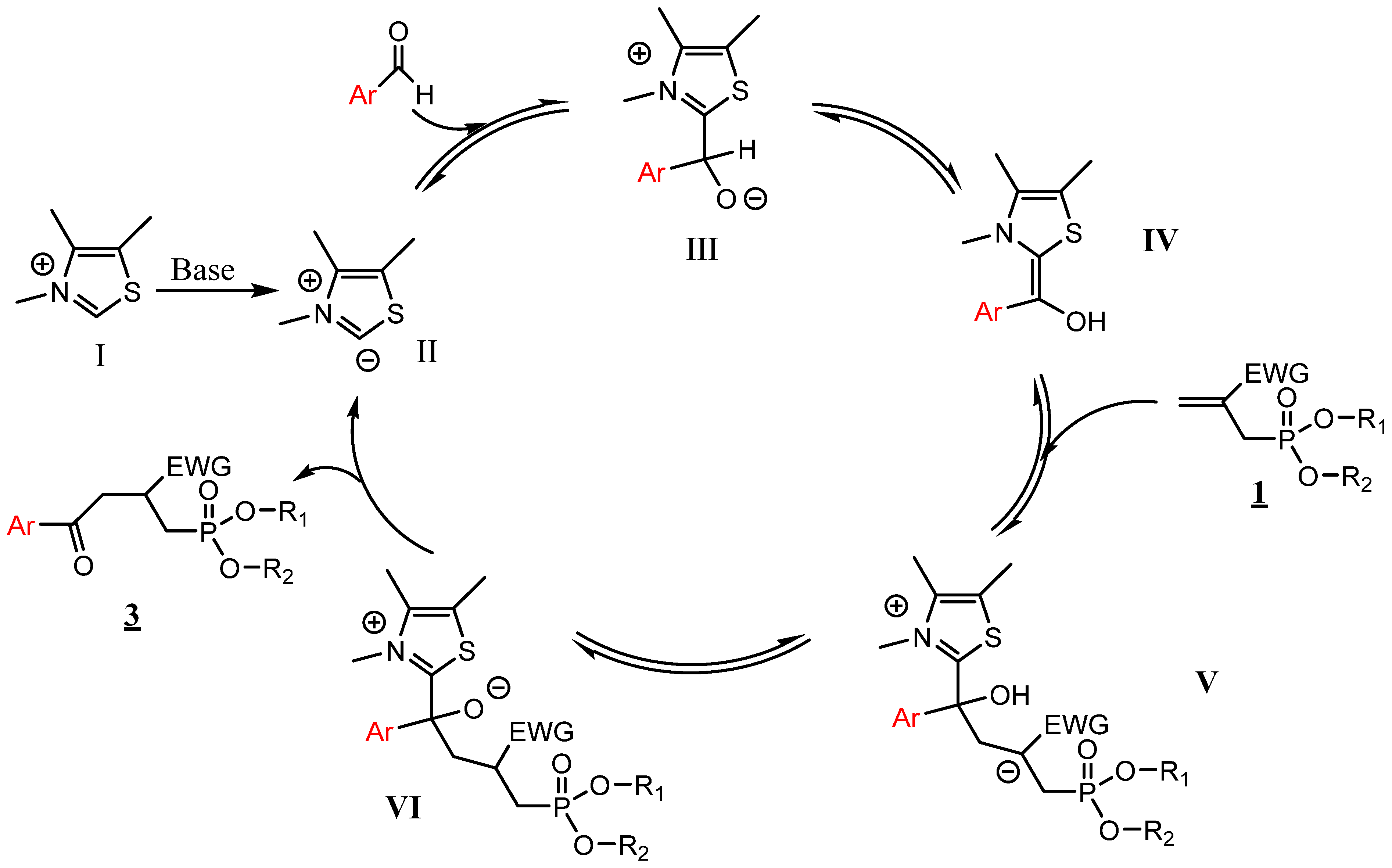
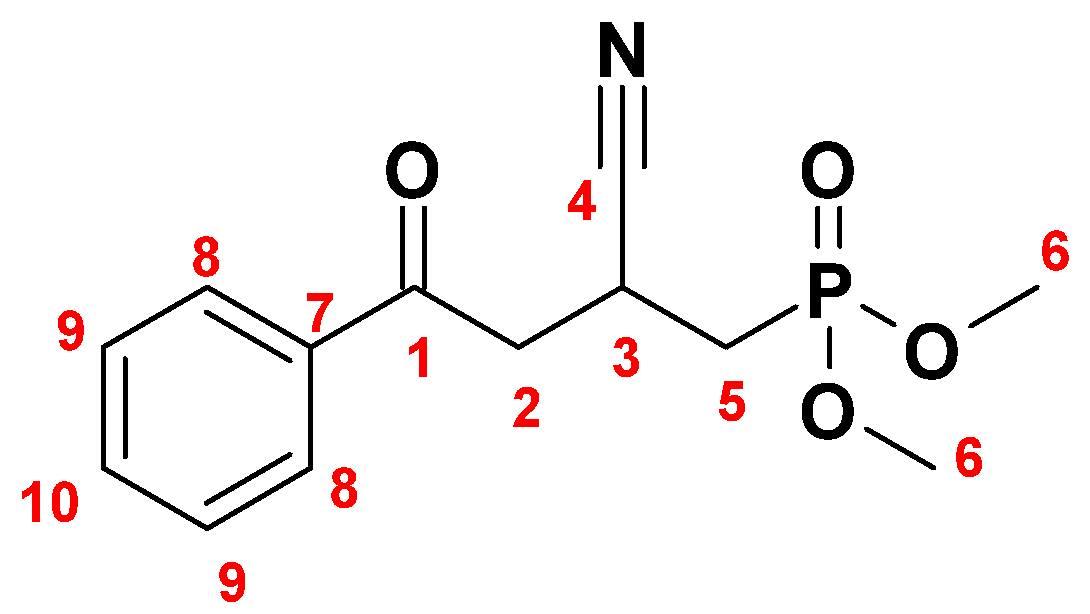
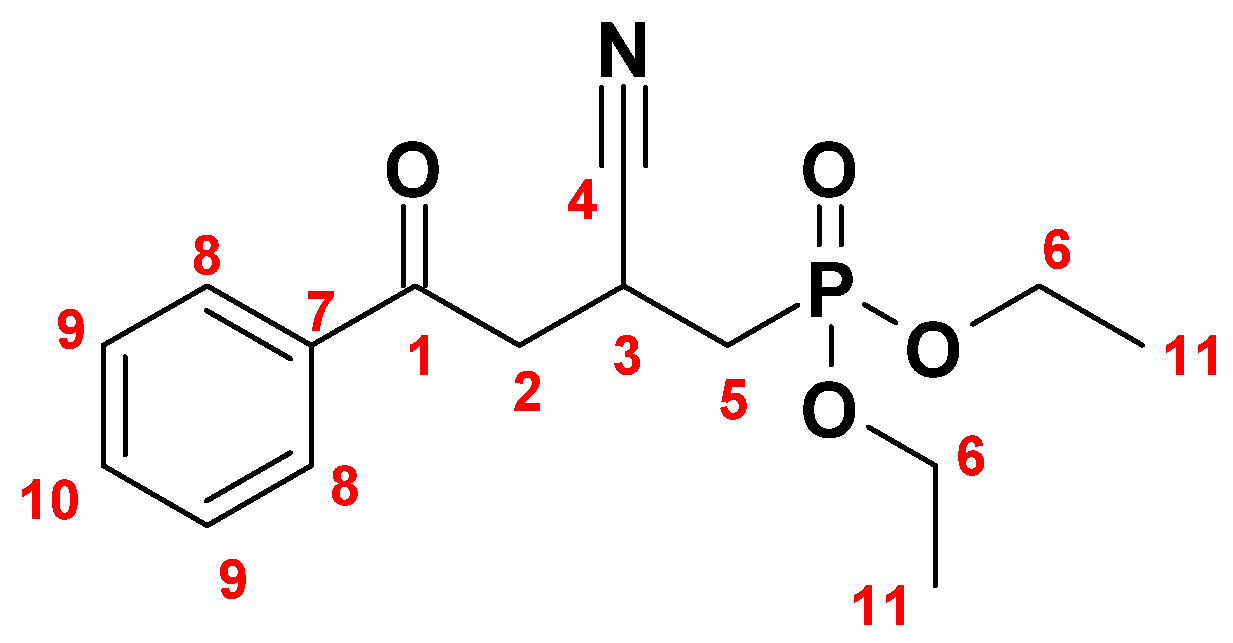
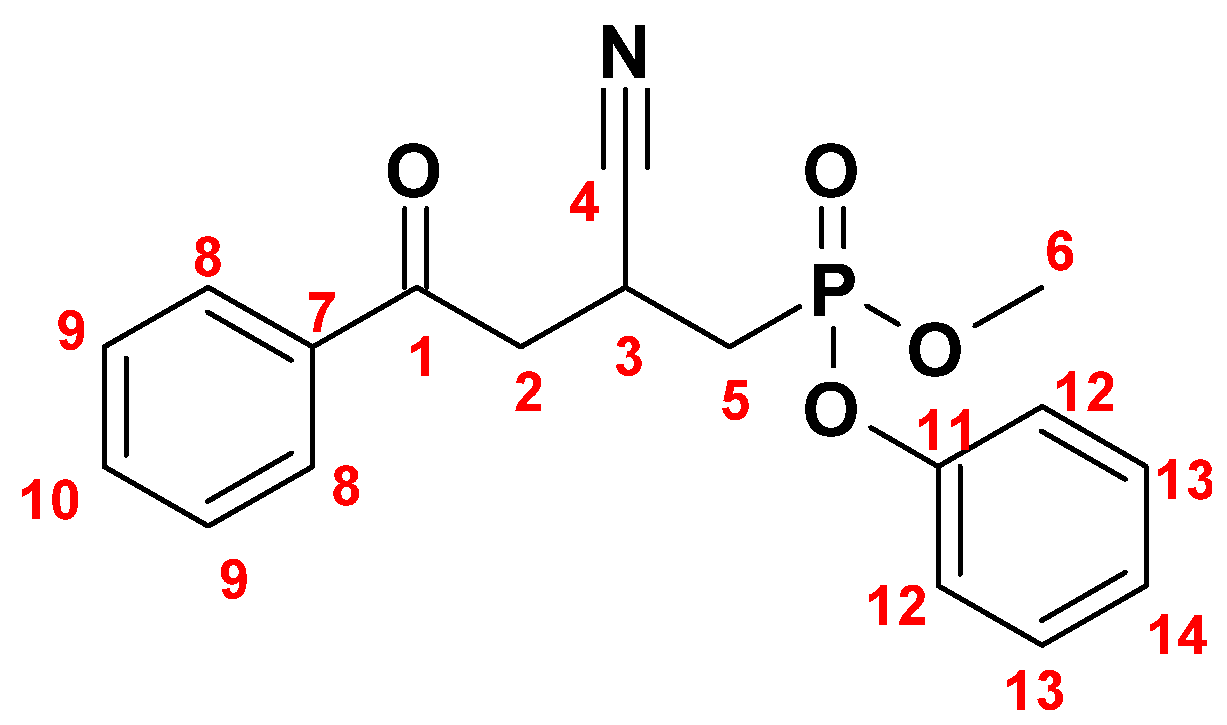
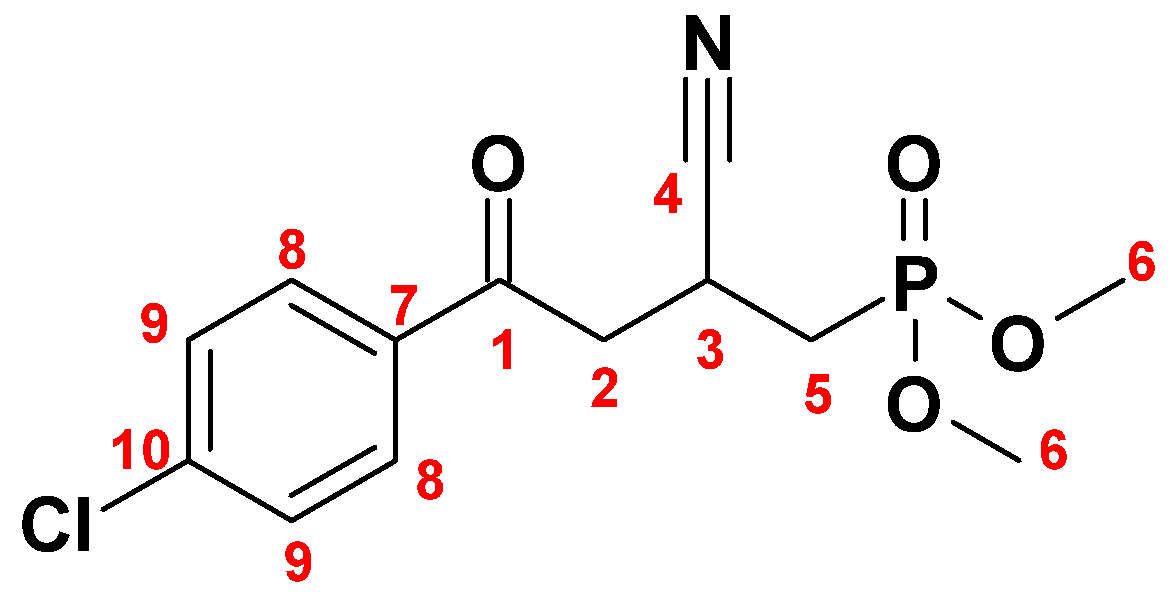
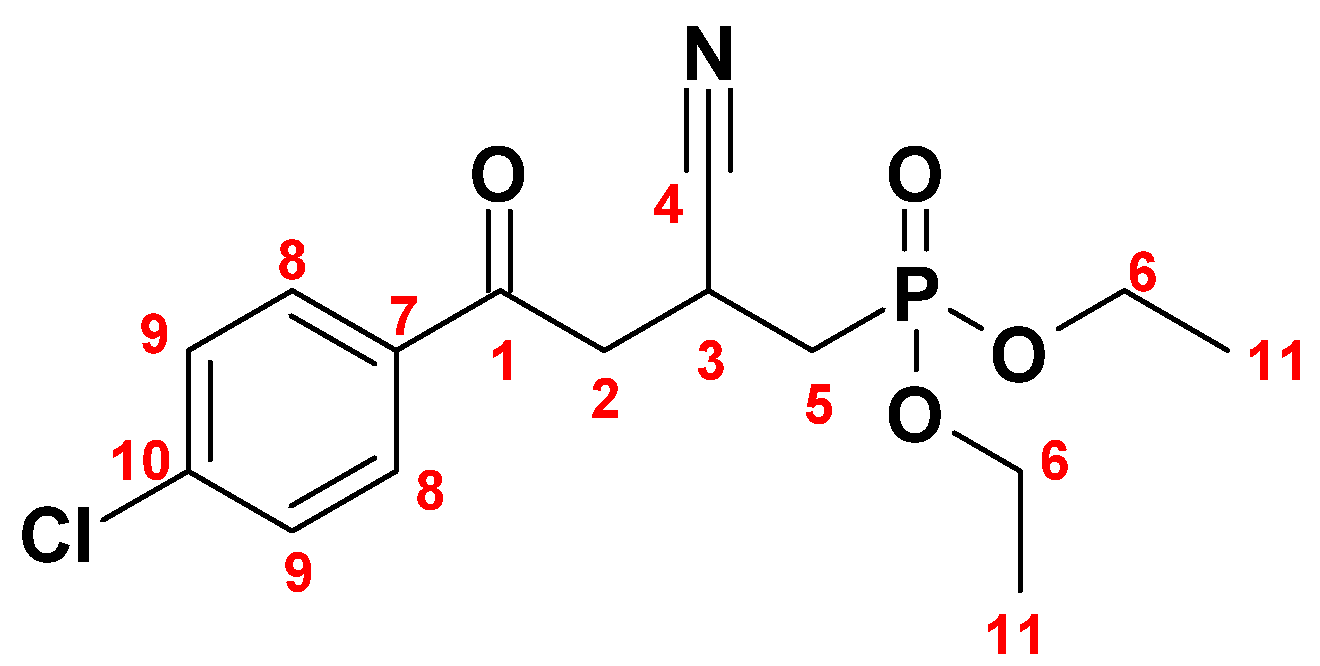
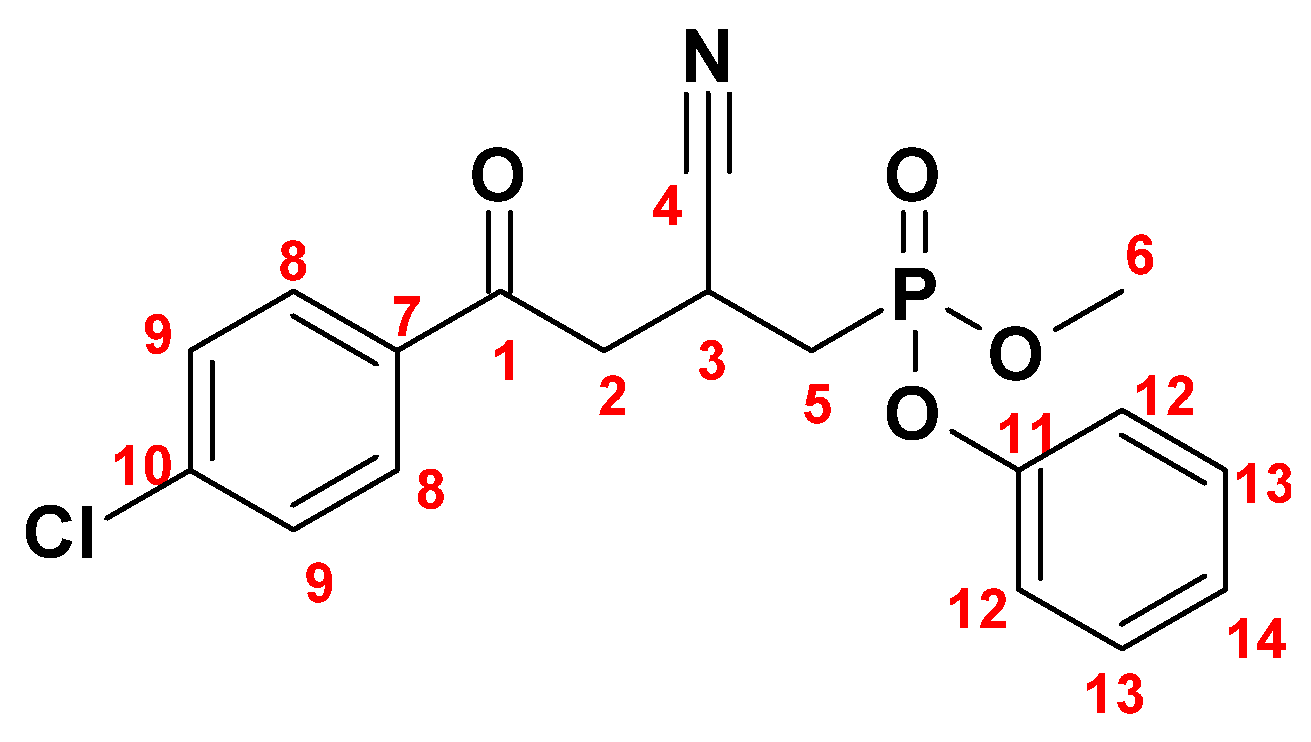
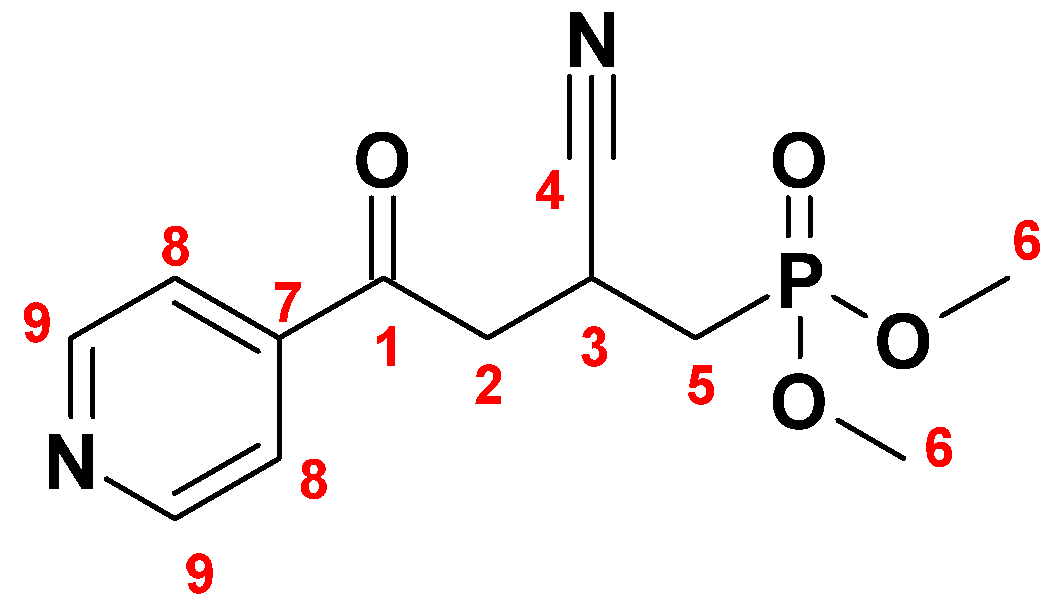
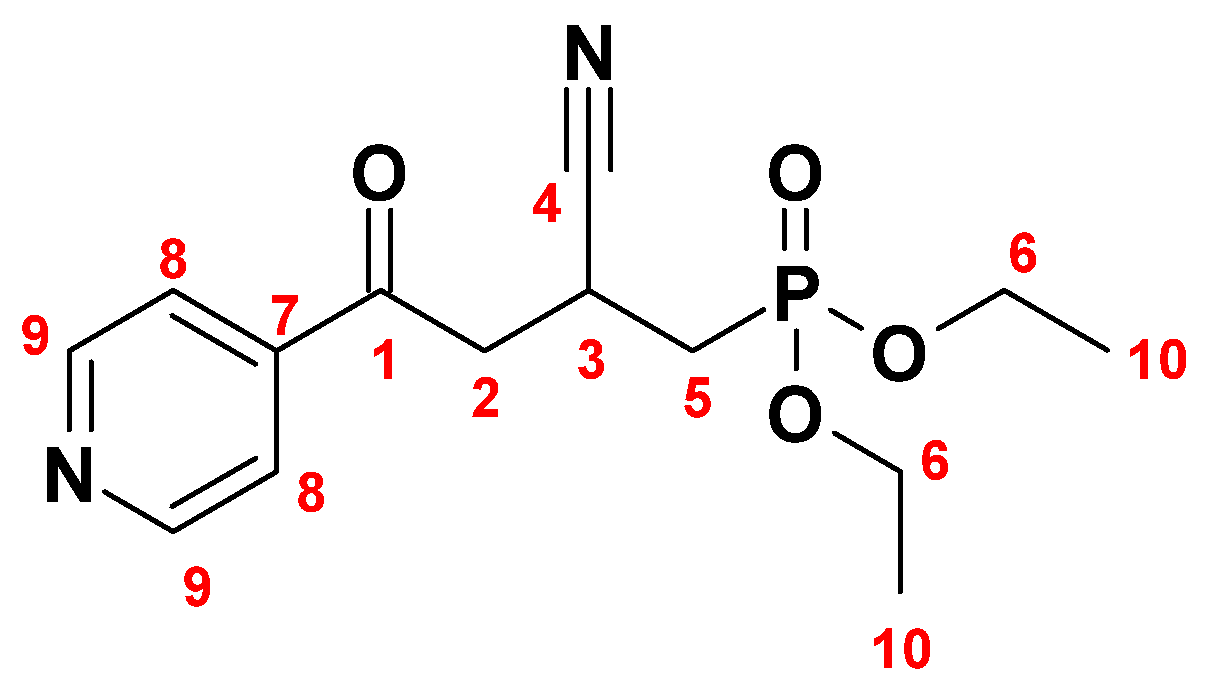
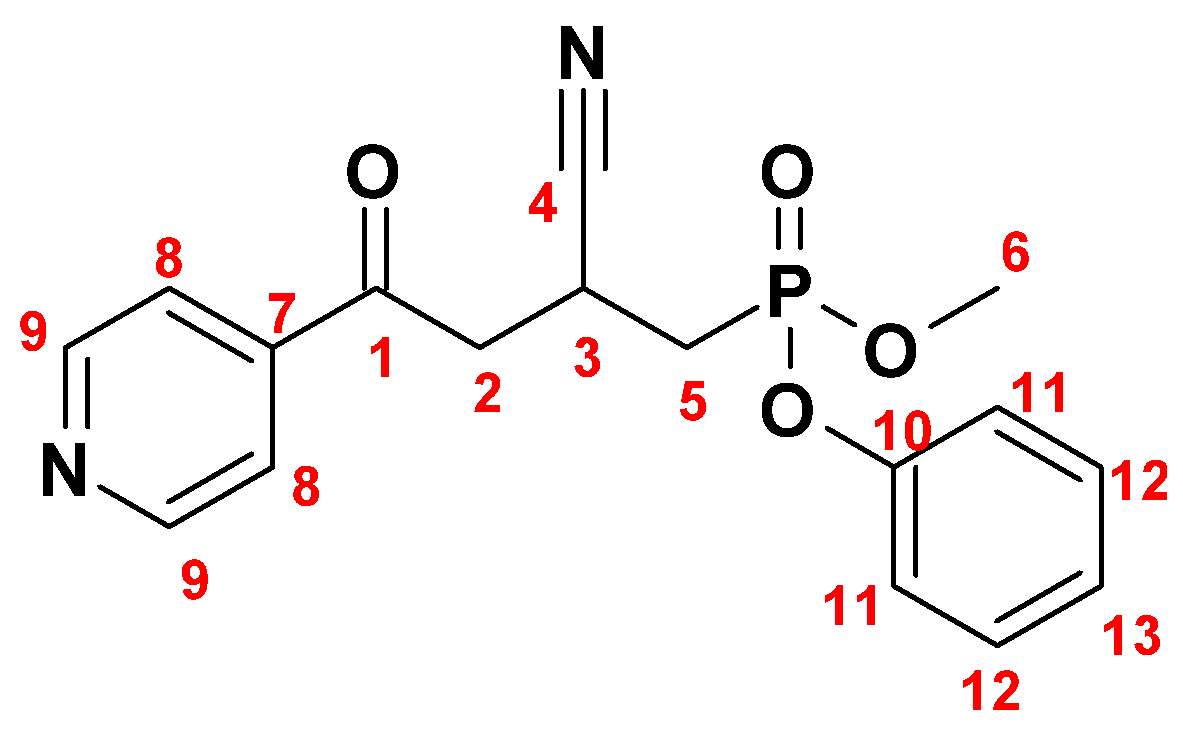
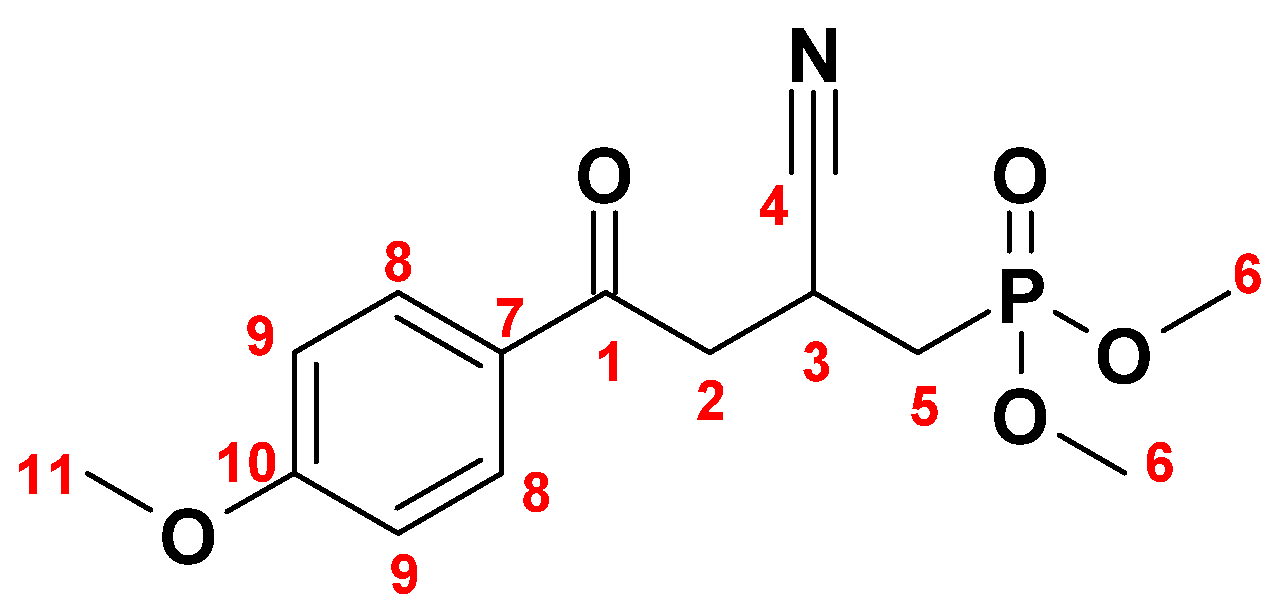
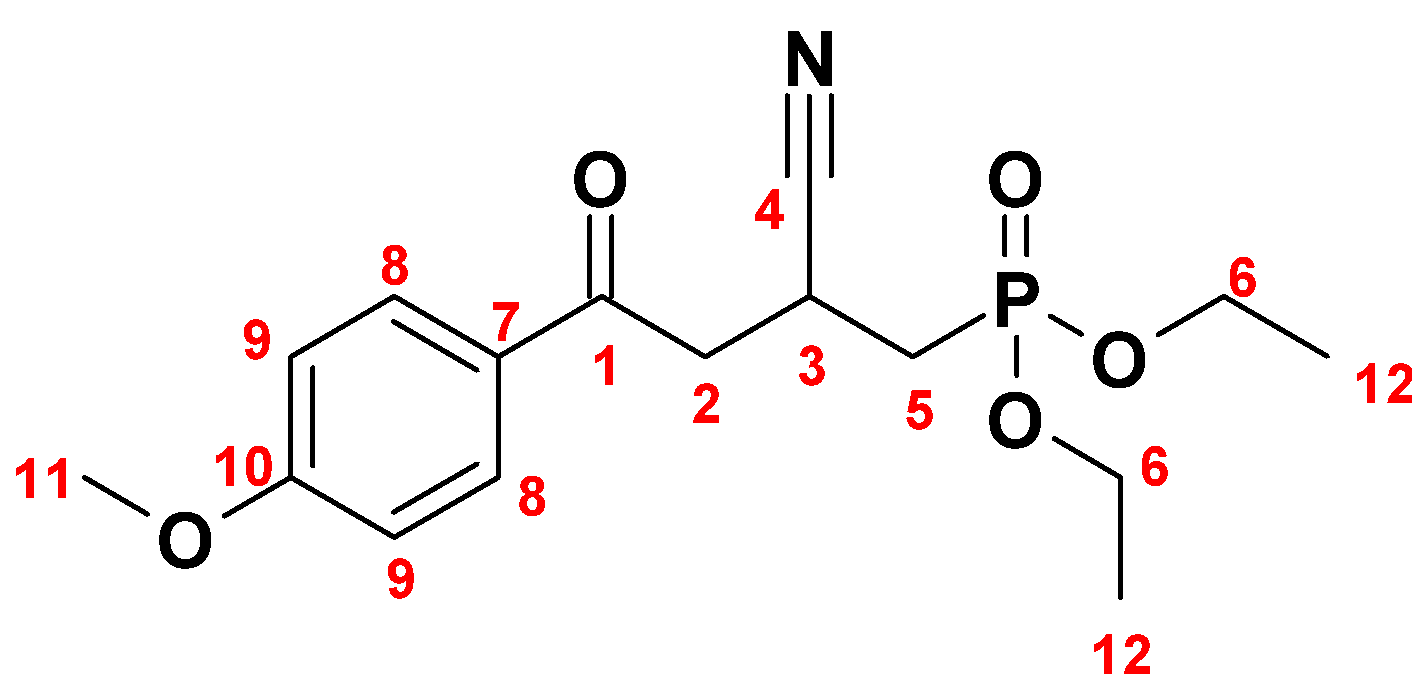
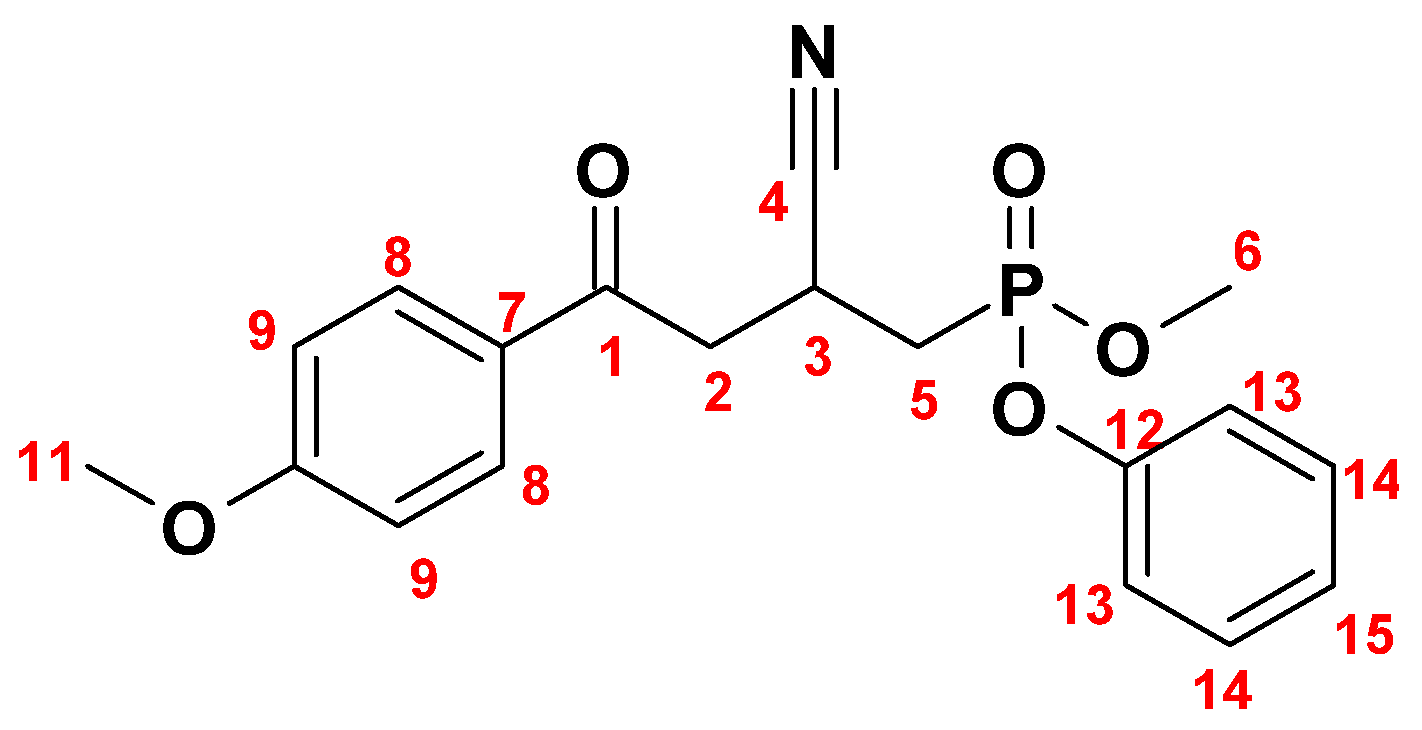
| Compounds | (1uk4) Binding Energy (ΔG)kcal/mol | (1e3k) Binding Energy (ΔG)kcal/mol |
|---|---|---|
| 3a | −6.34 | −6.64 |
| 3b | −6.67 | −6.94 |
| 3e | −7.01 | −9.01 |
| 5a | −8.20 | −9.08 |
| 5b | −7.32 | −9.39 |
| 5c | −7.91 | −9.67 |
| 5d | −7.99 | −8.01 |
| 5e | −8.44 | −8.56 |
| 5f | −9.14 | −9.09 |
| 5g | −7.01 | −8.05 |
| 5h | −6.46 | −9.56 |
| 5i | −8.65 | −10.41 |
| 5j | −7.36 | −8.77 |
| 5k | −6.83 | −9.49 |
Publisher’s Note: MDPI stays neutral with regard to jurisdictional claims in published maps and institutional affiliations. |
© 2022 by the authors. Licensee MDPI, Basel, Switzerland. This article is an open access article distributed under the terms and conditions of the Creative Commons Attribution (CC BY) license (https://creativecommons.org/licenses/by/4.0/).
Share and Cite
Yaccoubi, F.; Elleuch, H.; Mohamed, H.S.; Hamza, Z.S.; Zaki, Y.H. A Simple and Efficient Approach to the Synthesis of 4-Aryl-2-dialkylphosphonomethyl-4-oxobutanenitrile. Molbank 2022, 2022, M1342. https://doi.org/10.3390/M1342
Yaccoubi F, Elleuch H, Mohamed HS, Hamza ZS, Zaki YH. A Simple and Efficient Approach to the Synthesis of 4-Aryl-2-dialkylphosphonomethyl-4-oxobutanenitrile. Molbank. 2022; 2022(1):M1342. https://doi.org/10.3390/M1342
Chicago/Turabian StyleYaccoubi, Ferid, Hitham Elleuch, Hussein S. Mohamed, Zeinab S. Hamza, and Yasser H. Zaki. 2022. "A Simple and Efficient Approach to the Synthesis of 4-Aryl-2-dialkylphosphonomethyl-4-oxobutanenitrile" Molbank 2022, no. 1: M1342. https://doi.org/10.3390/M1342
APA StyleYaccoubi, F., Elleuch, H., Mohamed, H. S., Hamza, Z. S., & Zaki, Y. H. (2022). A Simple and Efficient Approach to the Synthesis of 4-Aryl-2-dialkylphosphonomethyl-4-oxobutanenitrile. Molbank, 2022(1), M1342. https://doi.org/10.3390/M1342








